Archive for November 2011
- Nov
- 22
Posted on November 22, 2011 by Nora DePalma
All set to feast? We can’t wait. O’Reilly/DePalma team members share the dishes that make Thanksgiving so memorable (and workouts so necessary).
Jen Datka: For the past several years I’ve been making Apple Honey Pie with Thyme for dessert. This year it’s being topped with homemade Maple-Rosemary Ice Cream, too
Erik Hoffer: My mom’s broccoli and cheese dish.
Mary Ann Blackburn: My favorite Thanksgiving recipe is Sweet Potato Casserole with Pecan Topping. It’s from my college roommate Linda (the roommate who actually cooks, not the other one). FYI, I am only allowed to use recipes at my house that have been made and recommended by Linda. This comes after several “experiments” with new recipes that didn’t go so well. As requested by my family.
Nora DePalma: Sausage stuffing, my mom’s recipe. With NO fruit. Do you hear me, Jim?
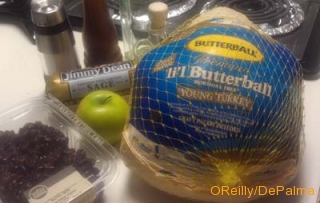
Jim Datka: World’s greatest gravy. Look for TWO fruits in your stuffing this year, DePalma.
Heather McCune: Cranberry Salad with Whipped Cream/Cream Cheese dressing. As light and luscious as it sounds.
Kelly Morris: I was given this Thanksgiving recipe 43 years ago when I was just a newlywed and it has been used in my kitchen since the day I said I do. This is why I enjoy the holiday so much. Bon Appetit
Recipe for Thanksgiving
1. Prepare the table with your finest dishes, silverware, tablecloth and a beautiful centerpiece
2. Take time for yourself before the meal by taking a long hot bubble bath accompanied by some bubbly
3. Slip into that sexy black dress you have been saving for a special occasion
4. Dab a little of that expensive perfume you have been saving
5. Light the candles
6. Call the store from which you ordered your meal
7. Sit down and enjoy!
Have a safe, wonderful enjoyable holiday from all of us to you and yours.
PS: Download the recipes for Sweet Potato Casserole with Pecan Topping, Honey Apple Pie With Thyme, and Maple Rosemary Ice Cream.
Read about more Thanksgiving food, fun and memories among this week’s Let’s Blog Off contributors. Learn more about Let’s Blog Off.
- Nov
- 21
Posted on November 21, 2011 by Nora DePalma
Klout scores are one of the best-known social media ranking tools. The definition of Klout gets a lot of scorn, because it is so obviously not an accurate indicator of influence (I hope):
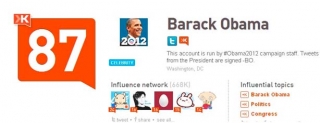

So, no. Klout scores are just one measurement of how fluent a given individual is in communicating via social media about things that interest people who use social media. To date, it has been heavily dependent on Twitter fluency. One might expect that a medium of 140 characters where spelling and grammar are mercilessly shredded might produce the above result.
Low Klout scores do not automatically mean someone is not a good social media consultant for your brand. It most certainly does not mean that someone is a poor influencer within the building and design communities. Our industry is not huge in the overall scheme of social media, which is dominated by celebrities and entertainment-related chat.
One benefit of Klout is that it helps illustrate why a social media investment is only worth it if your plan includes engagement, not just gaining more followers and fans. Klout measures interaction, not just raw numbers. In that way, Klout, as well as Peer Index, EdgeRank Checker and similar reporting tools are valuable in educating senior management that social media is an investment in relationships, not an arms race for followers. In my experience, good Klout scores in the building and design industry is any score higher than 30.
How Do Klout Scores Work?
Like Google and other search engines, Klout is an ever-evolving, highly-secretive algorithm. Which is why we wrote the headline as we did.
Klout describes its 1-100 score as measuring “influence based on your ability to drive action.” Note that “action” is not defined as driving a sale or visiting a website. That’s not how relationships work, although it may lead to such action, just as you rely on friends and family recommendations for many purchases. There are three basic components to the Klout algorithm:
True Reach: Total followers impact this measure, but in the context of how many of your followers are really engaging with you over time, based on conversations and retweets. It’ s not just about total followers.
Amplification: This measure dives deeper into how often your content is shared or discussed and by whom.
Network: This measure looks at the influence of your followers, taking into account their own True Reach and Amplification. This is the measure that keeps a lid on scores within the building and design industry. Few of us are in daily conversations with Ashton Kutcher or Justin Bieber. Few of us want to be.
In response to a considerable outcry among users, Klout is also working to remove volatility in the score that has come from lower use during weekends and vacations, also known as a having a life. (Check out this great post from a BlogHer member, Dear @Klout, Here’s What I Was Doing This Weekend.)
In summary, Klout scores are a measure, but not the measure, of influence on social media. Using Klout scores by themselves, such as the brands and agencies profiled in last Friday’s New York Times Klout story, is basically lazy. It would be like using CPM as the only determination of your ad spend, vs. digging into the audience and understanding the influence of a given media outlet.
Because humans are involved, understanding true influence is not likely to ever be determined by an algorithm.
- Nov
- 21
Posted on November 21, 2011 by Joel Williams
 In honor of World Toilet Day (11/19), National Public Radio’s Science Friday explored the surprising lack of access to sanitation faced by nearly 2.6 billion people — nearly one-third of the world’s population — as well as how engineers are making toilets more water efficient. Panelists included Jim McHale, vice president of engineering at American Standard, as well as several experts on global sanitation issues and civil engineering. Listen to the complete program here or watch a video.
In honor of World Toilet Day (11/19), National Public Radio’s Science Friday explored the surprising lack of access to sanitation faced by nearly 2.6 billion people — nearly one-third of the world’s population — as well as how engineers are making toilets more water efficient. Panelists included Jim McHale, vice president of engineering at American Standard, as well as several experts on global sanitation issues and civil engineering. Listen to the complete program here or watch a video.
- Nov
- 11
Posted on November 11, 2011 by Nora DePalma
 O’Reilly/DePalma principals Nora DePalma and John O’Reilly weigh in on the consequences for a building products brand that sparked a PR firestorm after being too heavy-handed with a respected industry blogger.
O’Reilly/DePalma principals Nora DePalma and John O’Reilly weigh in on the consequences for a building products brand that sparked a PR firestorm after being too heavy-handed with a respected industry blogger.
- Nov
- 10
Posted on November 10, 2011 by Nora DePalma
Once we had a solid case study that chronicled Loews Hotels and Resorts’ success using the American Standard Champion 4 toilet to solve the maintenance nightmare of 350 overflowing toilets each month, the pitch came together through serendipity, social media and the inimitable Peter Shankman.
As we were targeting and researching journalists who might find this story beneficial to their readers, we signed up for a Peter Shankman webinar featuring Barbara DeLollis of USA Today Hotel Check-In and the totally hilarious David Moye, pop culture reporter for HuffPost Weird News (former AOL Weird News).
As the Shankman seminar was underway, O’Reilly/DePalma colleagues Joel Williams and Nora DePalma texted between Chicago and Atlanta:
DePalma: Loews case study?
Williams: Yup, on it.
Williams read some of DeLollis’ columns and emailed a succinct and engaging pitch:
“Being naïve to all things hotels, I’d think top hotel chains would be focused on spacious, well appointed rooms, Egyptian cotton sheets and such – not a toilet. Loews and Hyatt, however, think the flush is more powerful than the fluff.”
Three days later, DeLollis featured our client in her USA Today Hotel Check-In column. DePalma followed up with some tweet love:

Which led to further mentions:
The Economist Business Travel Blog 2/11/2011
AOL Weird News 2/18/2011
Bayou Renaissance Man Blog 2/20/2011
Discovery Channel Online 2/25/2011
MSNBC 2/25/2011
eHotelier Global Hospitality News 2/21/2011
PM Plumbing & Mechanical 7/1/2011
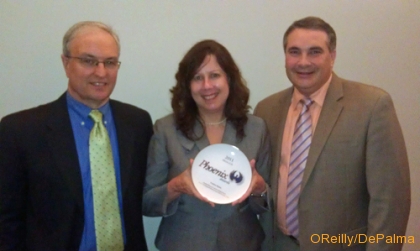
John O’Reilly, Nora DePalma, Joel Williams
On Thursday, November 3, one of the largest Public Relations Society chapters in the US, PRSA GA, awarded O’Reilly/DePalma and American Standard Brands a Phoenix Award in Feature Writing for this public relations case history about case histories.
To find out how we can tell great stories about your products, email John or Nora.
<<What is a Case Study Part 1
<<What is a Case Study Part 2
- Nov
- 9
Posted on November 9, 2011 by Joel Williams
Unlike commercial fire sprinkler systems, which were created primarily to protect property, residential sprinkler systems are designed for life safety and are intended to control the fire, allowing occupants to escape safely.
Therefore, residential sprinkler systems have significantly different, and often less complex, design and installation requirements than commercial systems.
Uponor’s Jayson Drake discusses the design and installation options for residential sprinkler systems as part of this month’s Plumbing Systems & Design magazine. Read more here.
- Nov
- 9
Posted on November 9, 2011 by Nora DePalma
Question: What is a case study and how can a story about the bathrooms at Loews Hotels garner 40 million impressions for a public relations’ client’s key messages?
Answer: It’s more than a case study or a customer testimonial. It’s a good story. One that a journalist recognizes as a good story. Which is defined as a story that people want to read.
A good story starts with asking the right questions of the right people. In the case of Loews, uncovering the story that Champion 4 toilet from American Standard reduced maintenance calls from overflowing toilets by 80% at their hotels and resorts took dogged pursuit of story leads, led by O’Reilly/DePalma account director Joel Williams.
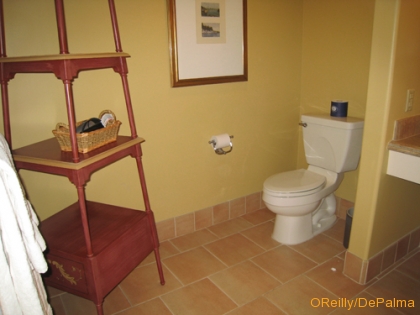
Service calls plunged at the Loews Portofino resort after installing the Champion 4 toilet
It started with a story lead, from the savvy American Standard sales executives who introduced Joel to three facilities managers associated with Loews. “I know what type of details editors are going to want to cover this story, so it’s my job to get the full scoop as efficiently as possible,” Williams said.
The glory is in the details, which means finding the best sources to tell your story. Calling sources and following leads brought Williams to Tony Rodrigues, Regional Director of Engineering for Loews Hotels at Universal Orlando.
Rodrigues was dealing with nearly 120 service calls each month that required a toilet plunger. As chief engineer overseeing three of Loews’ properties on-site at Universal Orlando Resort, multiply this plunger exercise by three and you can see where Rodrigues was ready to blow his lid (sorry).
Williams scored the money quote from Tony Rodrigues, after he put the American Standard Champion 4 to the test:
Maintenance calls at the Loews Portofino Bay property plunged more than 80 percent after replacing 750 Kohler® brand toilets with the American Standard Champion® 4 toilet.
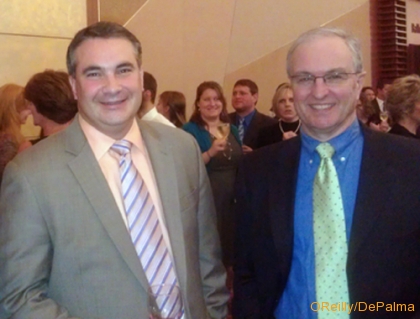
Seasoned brand journalists, Joel Williams and John O’Reilly
As you can see from Williams’s bio on our site, he didn’t just fall off the turnip truck when it comes to understanding building systems. He’s not a writer you can find for $23/hr. It takes knowledge and experience to gain credibility among building specifiers and installers.
And top tier journalists.
<< What is a Case Study Part 1 of 3
Next: What is a Case Study Part 3 of 3, a.k.a. Journalists Are People, Too >>
- Nov
- 8
Posted on November 8, 2011 by Nora DePalma
What is a case study? At its heart, a case study or a testimonial sample is an incredibly well-told story that compels people who experience it to buy into its value proposition.
“Great work. This is exactly the type of PR that makes a difference.”
-Chief Marketing Officer, American Standard Brands
Ten years into our relationship with American Standard Brands, O’Reilly/DePalma enjoyed such feedback after USA Today and The Economist travel blogs, as well as AOL News and others ran stories about how the Loews hotel chain saw maintenance calls for clogged toilets plunge 80% after the Champion 4 toilet was installed.
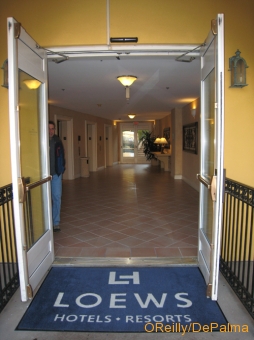
It all hinged on the money quote we sourced through solid brand journalism:
Maintenance calls at the Loews Portofino Bay property plunged more than 80 percent after replacing 750 Kohler® brand toilets with the American Standard Champion® 4 toilet.
We sent our findings around to influencers seeking trends in the hospitality industry and garnered fantastic coverage for American Standard and the Champion 4 toilet:
“‘Think about the embarrassment and inconvenience of a toilet clog,’ Dick Senechal, Loews’ senior vice president of facilities, who calls American Standard’s Champion 4 toilet an industry breakthrough, told me. ‘Eliminating that is a great service for our guests.’” — From Barbara DeLollis of USA Today Hotel Check-In.
“The chain has decided that enough is enough and is to upgrade the toilets across its properties. And we’re not talking any old loo. We’re talking American Standard’s Champion 4.” — From Gulliver, The Economist
“According to James Walsh, American Standard’s vice president and general manager of consumer fixtures, the Champion 4 proves that not all low-flow toilets do a crappy job. ‘The first generation of low-flow toilets had such poor performance that they left many people under the impression they weren’t, pardon the expression, worth a ‘crap,” said Walsh, whose knowledge of the inner workings of toilets has led some of his co-workers to call him ‘Professor Toilet.’” – From David Moye, AOL News
To date, this case study has garnered more than 40 million impressions and is a 2011 PRSA GA Phoenix Award winner for Feature Stories.
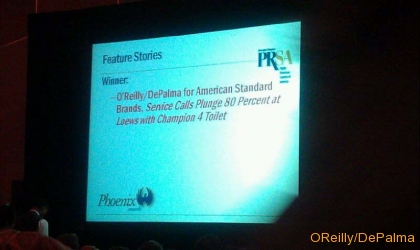
How do big-time “top-tier” media placements like this happen? Three not-so-simple steps:
1. Create a good quality product that solves a real problem. Your product has to do what it says it will do. Otherwise, the Internet will find you out and destroy you. Be authentic.
2. Hire people who know how to find and tell a compelling story so that prospects absorb your message. If you have never fast-forwarded through a TV ad or clicked impatiently through a marketing message to get to the story you want to read, we permit you to believe that you can still force-feed marketing messages.
3. Do your homework to identify the best media outlet and the best journalist to tell your story to a larger audience. Tailor the pitch, keep it channel-exclusive and follow up patiently and appropriately. Think about helping someone else (the journalist) instead of pushing them.
How do you find and tell a good story? It starts by asking the right questions of the right people. In the building products industry, that requires someone with the subject-matter expertise and journalistic tact to engage homeowners, developers, builders, architects, facilities managers, designers, contractors, specifiers and designers. (Remember, people: Don’t try this with a generalist PR agency junior account executive.)
Next: What is a Case Study Part 2
- Nov
- 2
Posted on November 2, 2011 by Nora DePalma
The adage, “you’re only as good as your tools,” is more pronounced in high-volume industries such as manufacturing and construction, where worker output directly drives profitability. For professional drywall contractors, an often overlooked means of greater productivity-and profits-is tools.
Read more about our Ames client: AWCI’s Construction Dimensions | Finishers Boost Productivity by 15 Percent with Better Tools.













